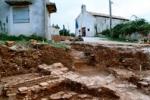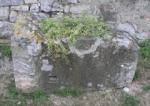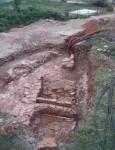Summary (English)
In September 2006, the Archaeological Museum of Istria conducted a rescue archaeological excavation near the church of St. Mary (S. Maria della Concetta) in the area of the power transformer station Galižana – Pumpa in the northern part of Galižana (traditionally called the village of Zigari). Along the southern road, about twenty meters from the church and next to the new and old transformer station, the original trench was widened to 7.20 × 5.20/3.60 m. The finds of Roman-period structures were modest remains and largely destroyed by recent excavations, and it was not possible to establish separate rooms. West of the installation excavation, two wider walls and a brick channel have been preserved, and to the east a plastered floor. The floor is 10 – 12 cm thick, made of white lime in places with small admixtures of ground Roman brick (3.50 × 0.56 × 1.00 m). Fragments of typical building bricks, one brick for a hypocaust column, several small tiles of floor mosaic (white tesserae), fragments of Roman amphorae, a vessel with a coarse texture, an illegible Roman bronze coin, a simple bronze arched fibula and part of a bone needle, were collected during the excavation. The Roman site also includes a stone monument without an inscription, observed at the farm building of the Turković family. It is a damaged altar or an architectural fragment carved in limestone and stepped in the upper and lower part.
The finds of the modest remains of Roman-period architecture were largely destroyed during the excavation of three recent installation channels and the foundations of the power transformer stations. According to residents, during the construction of the transformer station in 1953, three amphorae were found. The newly documented remains of the walls belong to the southeastern, residential part of a larger villa rustica on which the small Romanesque church of St. Maria “della Concetta” called “del Carso” was built (Marušić 1974; Matijašić 1988; Tarticchio 2003). In 1914, in front of the church façade, a larger room with a Roman-period oil mill was excavated (Gnirs 1914; Matijašić 1998). It had a floor in opus spicatum and two circular bases (area), apparently for pressing olives (Željko Ujčić 2007, Hrvatski arheološki godišnjak 3/2006, 228–229).
- Željko Ujčić
Director
- Željko Ujčić
Team
- Ivo Juričić
Research Body
- Arheološki muzej Istre
Funding Body
- Dalekovod d.d., za inženjering, proizvodnju i izgradnju, Zagreb






![Download [PDF]](/excavation/skins/fasti/images/results/download_sml.png)

